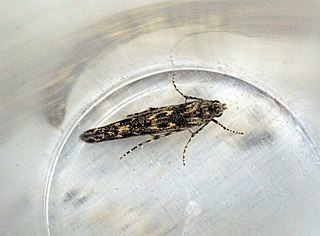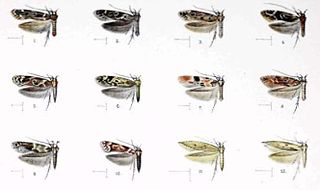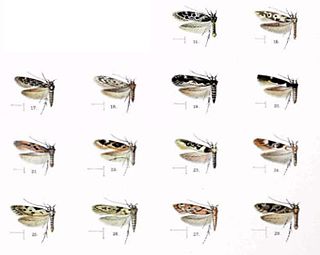Taxonomy
It was first described by Lord Walsingham in 1907 as Batrachedra microstigma from specimens collected at 2,000 feet (610 m) in altitude in the Waianae Mountains of Oahu by Robert Cyril Layton Perkins, and moved to the genus Chedra by Elwood Zimmerman in 1978. Upon closer examination of the original type series, Zimmerman determined that Walsingham had in fact collected two species, and described the new species Chedra mimica from some of those same specimens. Otto Herman Swezey collected larvae at a coastal marshland near the city of Honolulu known as 'Kewalo', now long lost to development, which he then reared to adult moths. These August Busck then described as Batrachedra cuniculator, which Zimmerman synonymised in 1978. [1] [2] [3]
Zimmerman re-designated a holotype from amongst the original type series. [1] The type for Batrachedra cuniculator is kept at National Museum of Natural History of the Smithsonian Institution. [3]
Zimmerman moved the entire Chedra genus, including this species, to the Momphinae subfamily of the family Gelechiidae in 1978. [1] Ron Hodges classified Chedra in the subfamily Batrachedrinae of the family Coleophoridae in his 1983 Check List of the Lepidoptera of America North of Mexico, [4] [3] but in 1999 he placed in the subfamily Batrachedrinae of the family Batrachedridae. [4] [5]
Distribution
It was described from Oahu, but is seen as possibly an introduced species. [1] This is due to remarks by Swezey when he collected the types for the taxon Batrachedra cuniculator near Honolulu. According to him it was odd that he had not noticed the species at an earlier date, [2] despite having lived in Hawaii for a few years.
When Zimmerman moved that taxon to his reclassified Chedra microstigma, he further remarked that besides the two Chedra species he had just classified as such, the genus Chedra was at that point only known from the New World, which meant the presence of the genus on Hawaii could be considered a biogeographic oddity. [1] At present, however, a new species has been discovered in the Philippines, C. fimbristyli, which is certainly native to those islands. [6] Zimmerman further theorised that the mode of invasion may have been the U.S. Army, which posted a large number of horses and mules on Oahu after the USA usurped the native government in 1893, and imported a large amount of hay and silage from the West Coast of North America as provender for this stock, in which stalks the caterpillars may have hitched a ride. Note, however, that this was only around a decade before Lord Walsingham collected his type series in the island interior. [1]

The Batrachedridae are a small family of tiny moths. These are small, slender moths which rest with their wings wrapped tightly around their bodies.

Batrachedra is the largest genus in the moth family Batrachedridae, with representatives all over the world. The early stages of most species are unknown. The genus name is derived from the Greek words batrachos, 'frog', and edra, 'seat', referring to the frog-like resting posture of the adult moths. As of 2018 at least some 114 species are known to belong to the genus.

Cyperus laevigatus is a species of sedge known by the common name smooth flatsedge.

Chedra is a genus of tiny moths, belonging to the family Batrachedridae.
Macraesthetica is a monotypic moth genus belonging to the subfamily Olethreutinae of the family Tortricidae. The genus was erected by Edward Meyrick in 1932. It contains only one species, Macraesthetica rubiginis, which is only known from the Hawaiian island of Oahu. The species was first described by Lord Walsingham in 1907.
Mantua is a monotypic moth genus belonging to the subfamily Tortricinae of the family Tortricidae. The genus was first described by Elwood Zimmerman in 1978. Its only species, Mantua fulvosericea, was first described by Lord Walsingham in 1907. It is endemic to the Hawaiian islands of Kauai, Oahu, Molokai and Lanai.
Hyposmocoma argyresthiella is a species of moth of the family Cosmopterigidae. It was first described by Lord Walsingham in 1907. It is endemic to the Hawaiian islands of Kauai, Oahu, Molokai and Hawaii. The type locality is Kaawaloa, Kona, where it was collected at an elevation above 2,000 feet (610 m).
Hyposmocoma ferruginea is a species of moth of the family Cosmopterigidae. It was first described by Otto Swezey in 1915. It is endemic to the Hawaiian island of Oahu. The type locality is Mount Olympus.

Hyposmocoma radiatella is a species of moth of the family Cosmopterigidae. It was first described by Lord Walsingham in 1907. It is endemic to the Hawaiian islands of Kauai, Oahu, Molokai and Hawaii. The type locality is Kona, where it was collected at an elevation of 4,000 feet (1,200 m).

Hyposmocoma alliterata is a species of moth of the family Cosmopterigidae. It was first described by Lord Walsingham in 1907. It is endemic to the Hawaiian islands of Oahu, Molokai, Maui and Hawaii. This species is thought to range from the lowlands to the highlands, where it is most abundant.

Hyposmocoma auropurpurea is a species of moth of the family Cosmopterigidae. It was first described by Lord Walsingham in 1907. It is endemic to the Hawaiian island of Oahu. The type locality is the Waianae Range.
Hyposmocoma elegantula is a species of moth of the family Cosmopterigidae. It was first described by Otto Herman Swezey in 1934. It is endemic to the Hawaiian island of Oahu. The type locality is Koko Head.

Hyposmocoma inversella is a species of moth of the family Cosmopterigidae. It was first described by Lord Walsingham in 1907. It is endemic to the Hawaiian island of Oahu. The type locality is the Waianae Range, where it was collected at an elevation of 2,000 feet (610 m).

Hyposmocoma liturata is a species of moth of the family Cosmopterigidae. It was first described by Lord Walsingham in 1907. It is endemic to the Hawaiian islands of Oahu and Hawaii. The type locality is Kona, where it was collected at an elevation of 4,000 feet (1,200 m).
Asymphorodes dimorpha is a species of gelechioid moth of subfamily Agonoxeninae of the palm moth family (Agonoxenidae), whose taxonomic status is disputed. Alternatively, the palm moths might be a subfamily of the grass-miner moth family (Elachistidae), with the Agonoxeninae becoming a tribe Agonoxenini.
Mapsidius auspicata is a moth of the family Scythrididae. It was first described by Lord Walsingham in 1907. It is endemic to the Hawaiian islands of Kauai, Oahu, Lanai and Hawaii.
Thyrocopa abusa is a moth of the family Xyloryctidae. It was first described by Lord Walsingham in 1907. It is endemic to the Hawaiian islands of Kauai, Oahu, Molokai, Lanai, Maui and Hawaii. It is the type species of the genus Thyrocopa.
Chedra mimica is a tiny moth of the family Batrachedridae known from Hawaii.
Batrachedrodes is a genus of moths of the Momphidae family. All species of this genus are endemic to the Hawaiian Islands.
Batrachedrodes bedelliella is a moth of the family Momphidae. It was first described by Lord Walsingham in 1907. It is endemic to the Hawaiian islands. As of 1978, the distribution is not entirely clear. It is thought to be native to Oahu, Molokai, Maui and Hawaii, however only specimens from Maui and Molokai are certainly collected on those islands. The holotype was collected at Haleakala in Maui at 5,000 feet (1,500 m) elevation.









